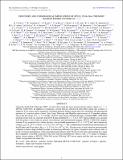DISCOVERY AND COSMOLOGICAL IMPLICATIONS OF SPT-CL J2106-5844, THE MOST MASSIVE KNOWN CLUSTER AT z > 1
Author(s)
Andersson, Karl; Bautz, Marshall W.
DownloadFoley-2011-DISCOVERY AND COSMOL.pdf (1016.Kb)
PUBLISHER_POLICY
Publisher Policy
Article is made available in accordance with the publisher's policy and may be subject to US copyright law. Please refer to the publisher's site for terms of use.
Terms of use
Metadata
Show full item recordAbstract
Using the South Pole Telescope (SPT), we have discovered the most massive known galaxy cluster at z>1, SPT-CL J2106-5844. In addition to producing a strong Sunyaev-Zel'dovich (SZ) effect signal, this system is a luminous X-ray source and its numerous constituent galaxies display spatial and color clustering, all indicating the presence of a massive galaxy cluster. Very Large Telescope and Magellan spectroscopy of 18 member galaxies shows that the cluster is at z = 1.132[+0.002 over –0.003]. Chandra observations obtained through a combined HRC-ACIS GTO program reveal an X-ray spectrum with an Fe K line redshifted by z = 1.18 ± 0.03. These redshifts are consistent with the galaxy colors found in optical, near-infrared, and mid-infrared imaging. SPT-CL J2106-5844 displays extreme X-ray properties for a cluster having a core-excluded temperature of T[subscript X] = 11.0[+2.6 over –1.9] keV and a luminosity (within r [subscript 500]) of L[subscript X] (0.5-2.0 keV) = (13.9 ± 1.0) × 10[superscript 44] erg s[superscript –1]. The combined mass estimate from measurements of the SZ effect and X-ray data is M [subscript 200] = (1.27 ± 0.21) × 10[superscript 15] h [–1 over 70] M [subscript ☉]. The discovery of such a massive gravitationally collapsed system at high redshift provides an interesting laboratory for galaxy formation and evolution, and is a probe of extreme perturbations of the primordial matter density field. We discuss the latter, determining that, under the assumption of ΛCDM cosmology with only Gaussian perturbations, there is only a 7% chance of finding a galaxy cluster similar to SPT-CL J2106-5844 in the 2500 deg[superscript 2] SPT survey region and that only one such galaxy cluster is expected in the entire sky.
Date issued
2011-03Department
MIT Kavli Institute for Astrophysics and Space ResearchJournal
The Astrophysical Journal
Publisher
IOP Publishing
Citation
Foley, R. J., K. Andersson, G. Bazin, T. de Haan, J. Ruel, P. A. R. Ade, K. A. Aird, et al. “DISCOVERY AND COSMOLOGICAL IMPLICATIONS OF SPT-CL J2106-5844, THE MOST MASSIVE KNOWN CLUSTER AT z >1.” The Astrophysical Journal 731, no. 2 (March 28, 2011): 86. © 2011 The American Astronomical Society
Version: Final published version
ISSN
0004-637X
1538-4357